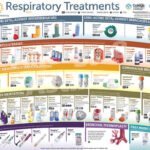
In this article, we will discuss the best practices for managing respiratory emergencies. From recognizing the symptoms to providing prompt and effective treatment, these strategies will help you navigate through these critical situations with confidence. By understanding the importance of early intervention and implementing proper protocols, you can ensure the best possible outcomes when faced with respiratory emergencies. So, let’s dive in and explore these essential practices that could potentially save lives.
Recognizing Respiratory Emergencies
When it comes to managing respiratory emergencies, one of the most important steps is recognizing the signs and symptoms that indicate a problem. These can vary depending on the specific emergency, but there are some common factors to look out for. Difficulty breathing, shortness of breath, chest pain, coughing up blood, and wheezing are all indicators that immediate medical attention is needed. Other signs may include pale or bluish skin, confusion or disorientation, and a rapid or irregular heartbeat. By being aware of these signs and symptoms, you can take quick action and potentially save a life.
Differentiating between respiratory emergencies and other medical conditions is also crucial. While some symptoms may mimic those of other conditions, it’s important to focus on the respiratory aspect. If a patient is experiencing severe shortness of breath or struggling to breathe, it’s likely a respiratory emergency. However, if the symptoms are more generalized or not respiratory-related, it may be a different medical issue. This distinction allows for appropriate treatment options and ensures the best possible outcome for the patient.
Assessing the severity of the situation is the next step in managing respiratory emergencies. This involves evaluating the patient’s overall condition and determining the urgency of the situation. Is the patient able to speak or communicate? Are they displaying signs of respiratory distress, such as gasping for air or using accessory muscles to breathe? Assessing the severity helps in determining the appropriate actions to be taken and allows emergency medical services to be notified promptly if necessary.
Immediate Actions
In any respiratory emergency, time is of the essence. The following immediate actions should be taken to address the situation before medical professionals arrive:
Calling for emergency medical assistance is the first and most crucial step. Dial your local emergency number and provide them with all the necessary information about the patient’s condition. Be prepared to provide a concise and accurate description of the symptoms and any relevant medical history.
Providing basic life support, such as cardiopulmonary resuscitation (CPR), may be necessary in certain situations. If the patient is not breathing or is unconscious, CPR should be initiated promptly until professional help arrives. CPR involves chest compressions and rescue breaths, and it can help maintain circulation and oxygenation.
Ensuring an open airway is vital in respiratory emergencies. If there is any obstruction, such as vomit, blood, or foreign material, it must be cleared to allow for adequate airflow. Tilting the head back slightly and lifting the chin can also help open the airway.
Administering supplemental oxygen, if available, is another immediate action to consider. Supplemental oxygen can help improve oxygen levels in the blood and alleviate respiratory distress. If you have access to an oxygen tank or mask, follow the instructions for safe and proper use.
Positioning the patient for optimal breathing is important as well. Depending on the specific emergency, there may be a preferred position that facilitates easier breathing. This could involve sitting the patient upright or placing them on their side. The goal is to reduce any potential obstruction and allow for better airflow.

Managing Asthma Attacks
Asthma attacks are a common respiratory emergency that requires prompt management. When confronted with an asthma attack, it’s important to:
Assess the severity of the attack. Asthma attacks can range from mild to severe, and the appropriate treatment will depend on the severity. Mild attacks may involve wheezing and coughing with minimal difficulty breathing, while severe attacks could include extreme shortness of breath and the inability to speak.
Administer quick-relief medication, such as inhalers, as prescribed by the patient’s healthcare provider. Inhalers containing bronchodilators can help relax the airway muscles and relieve symptoms. It’s crucial to follow the patient’s specific instructions for using the inhaler and to ensure they receive the correct dosage.
Monitor the patient’s oxygen saturation levels using a pulse oximeter. This device measures the oxygen saturation in the blood and provides an indication of how well the patient is being oxygenated. Regular monitoring during an asthma attack can help determine if additional interventions or medical attention may be required.
Provide education on asthma management and trigger avoidance. Asthma attacks can often be triggered by specific allergens or environmental factors. By teaching the patient how to identify and avoid these triggers, you can help them reduce the frequency and severity of future attacks.
Create an asthma action plan in collaboration with the patient and their healthcare provider. An asthma action plan outlines specific steps to be taken during an attack, including when to seek emergency medical assistance. This plan serves as a guide for both the patient and their caregivers during an asthma emergency.
Treating Anaphylaxis
Anaphylaxis is a severe allergic reaction that requires immediate attention. To effectively manage anaphylaxis, consider the following:
Administer epinephrine (adrenaline) via an auto-injector if available. Epinephrine is the first-line treatment for anaphylaxis and can rapidly reverse the allergic reaction. The auto-injector is designed for easy use and should be administrated according to the specific instructions provided.
Position the patient in a comfortable position, typically lying flat on their back with their legs elevated. This can help improve blood flow and reduce the risk of complications.
Monitor vital signs, including heart rate, blood pressure, and respiratory rate, and ensure adequate oxygenation. Anaphylaxis can cause a drop in blood pressure, difficulty breathing, and other serious symptoms. Regular monitoring is essential to assess the patient’s response and identify any deterioration.
Prepare for possible additional medications or advanced interventions. In some cases, antihistamines, corticosteroids, or additional doses of epinephrine may be required. Furthermore, advanced interventions such as intubation or intravenous fluids may be necessary depending on the severity of the anaphylactic reaction.

Addressing Acute Respiratory Infections
When it comes to managing respiratory infections, early intervention is key. Take the following steps:
Assess the severity of the infection and identify the causative agent. The symptoms of respiratory infections can vary, ranging from mild coughs to severe respiratory distress. Determining the severity helps guide appropriate treatment decisions.
Provide appropriate antibiotic therapy if prescribed. In cases where the respiratory infection is bacterial, antibiotics may be needed to fight the infection. It’s vital to follow the prescribed dosage and duration, ensuring the antibiotics are taken as directed.
Ensure adequate hydration and respiratory support. Drinking fluids and maintaining proper hydration can help loosen mucus and facilitate its removal. Humidifiers or steam inhalation may also help relieve congestion and provide temporary relief.
Monitor for complications or worsening symptoms. Respiratory infections can sometimes lead to complications such as pneumonia or worsening respiratory distress. Regular monitoring of symptoms, vital signs, and overall well-being is crucial to identifying any deterioration.
Managing Respiratory Distress in Children
Respiratory distress in children requires special attention and care. Follow these steps:
Recognize the unique signs and symptoms in children. Children may not always exhibit traditional signs of respiratory distress, such as wheezing or shortness of breath. In infants, signs may include a rapid breathing rate, flaring nostrils, grunting, or retractions (visible sinking of the skin between the ribs or above the collarbones). Older children may complain of chest pain, fatigue, or difficulty breathing.
Maintain calm and reassure the child and their parents. Anxiety or fear can exacerbate respiratory distress. By remaining calm and reassuring, you can help create a more relaxed environment that promotes better breathing for the child.
Administer appropriate medications, such as nebulized bronchodilators, as prescribed by a healthcare provider. These medications help relax the airways and alleviate symptoms. It’s essential to follow dosage instructions and observe the child closely for any adverse reactions.
Monitor closely for signs of improvement or deterioration. Respiratory distress in children can change rapidly, so it’s important to closely observe how the child is responding to treatment. Look for improvements in breathing, speak with the child, and check for any signs of worsening distress.

Responding to Choking Incidents
Choking incidents require immediate action to remove the obstruction and restore proper breathing. Follow these guidelines:
Assess the severity of the obstruction. If the person is unable to speak, cough, or breathe, it is likely a severe obstruction. In this case, you should take immediate action to dislodge the object.
Perform abdominal thrusts (Heimlich maneuver) if the person is conscious. Stand behind the choking individual, place your hands above their navel, and deliver firm upward thrusts. Repeat this maneuver until the obstruction is dislodged or the person becomes unconscious.
Perform chest thrusts if the person is unconscious. For unconscious individuals or individuals unable to stand, chest thrusts can be performed as an alternative to the Heimlich maneuver. Place one hand on the center of the person’s chest and the other hand on top, and deliver firm inward and upward thrusts. Continue until the obstruction is cleared or help arrives.
Call emergency services if the obstruction is not relieved. If the obstruction cannot be cleared using the above techniques or the person becomes unconscious, call emergency services immediately. Provide detailed information about the situation and follow their instructions until help arrives.
Dealing with Respiratory Arrest
Respiratory arrest, the complete cessation of breathing, is a life-threatening emergency. Take the following steps to address it:
Recognize the absence of breathing and unresponsiveness. If a person is not breathing, check for responsiveness by gently shaking their shoulders and asking loudly if they are okay. Lack of breathing and unresponsiveness indicate respiratory arrest.
Initiate cardiopulmonary resuscitation (CPR) immediately. Begin CPR by providing chest compressions to circulate oxygenated blood to vital organs. Compressions should be performed at a rate of about 100 to 120 compressions per minute, allowing for full chest recoil between each compression.
Request an automated external defibrillator (AED) if available. AEDs are devices used to deliver electrical shocks to the heart in cases of cardiac arrest. If an AED is accessible, follow the device’s instructions and attach the electrodes to the person’s chest as directed.
Continue CPR until professional help arrives or the person shows signs of spontaneous breathing or other signs of recovery.
Providing Supportive Care
Supportive care is crucial for individuals with respiratory emergencies. Here’s what you can do:
Ensure a calm and reassuring environment for the patient. Anxiety and stress can worsen respiratory distress, so creating a peaceful environment can help alleviate these feelings. Speak calmly and provide reassurance to the patient, as well as addressing any concerns they may have.
Administer medication as prescribed for underlying conditions. For individuals with pre-existing respiratory conditions or related comorbidities, ensuring they receive their prescribed medications is important. Follow the recommended dosage and frequency, and monitor for any adverse effects.
Monitor vital signs and oxygen saturation continuously. Regularly check the patient’s heart rate, blood pressure, respiratory rate, and oxygen saturation levels. This ongoing monitoring provides valuable information about their condition and helps guide further interventions if needed.
Maintain proper hydration and nutritional support. Good hydration helps thin mucus, making it easier to clear from the airways. Adequate nutrition supports overall well-being and can aid in recovery. Offer fluids and nourishing meals as appropriate, considering any dietary restrictions or recommendations from healthcare providers.
Seeking Professional Training
To be better prepared for respiratory emergencies, consider acquiring professional training. Here are some steps you can take:
Complete basic life support (BLS) and advanced cardiac life support (ACLS) courses. BLS and ACLS courses provide valuable knowledge and skills in managing cardiac and respiratory emergencies. These courses teach life-saving techniques such as CPR, defibrillation, and airway management. Completing these courses can help ensure you have the necessary skills to respond effectively in respiratory emergencies.
Attend specific respiratory emergency management workshops or seminars. Many organizations and healthcare institutions offer workshops or seminars specifically focused on respiratory emergency management. These events provide the opportunity to learn from experts in the field, gain insights into best practices, and refine your skills.
Stay up-to-date with the latest guidelines and protocols. Medical guidelines and protocols for managing respiratory emergencies are constantly evolving. Stay informed by regularly reviewing updated guidelines and staying current with new research and recommendations. This knowledge ensures that your practices align with the most current evidence-based standards of care.









